When shopping for knuckleboom cranes, buyers have much to consider in deciding which class size they should buy. Because the purchase is for an entire crane package, even the chassis must be part of the equation. Manufacturers says the first consideration is reach, followed by load. Once those two factors are determined, everything else, including the truck chassis on which the crane will be mounted, will fall into place.
“Basically, the first thing you need to know is how much the load is you want to lift and the radius you want to lift it in,” says John Field, product manager for material handling systems at Iowa Mold Tooling, Garner, Iowa. That gets you to the initial crane size to start the process.” Other issues to consider include how the crane is to be used; whether it will be operated from the front, side, or back; if it will be used for continuous duty cycle, such as in recycling applications, or for periodic use, such as material deliveries. “Another specification is the overall weight of the vehicle,” says Greg Sneek, knuckleboom product manager, Palfinger Cranes, Niagara Falls, Ontario.
“The use of high-quality, lightweight steel allows customers to have more payload since the weight of the crane can affect the GVW considerably.” Bob Fischer, Fischer Crane Co.,Bolingbrook, Ill., says the buyer needs to determine their overall desired reach and the capacity at that desired reach. Additionally, there may be other capacity-versus-reach equations to consider. An example would be a power company’s need to unload 20,000-pound transformers off the truck and onto the ground at a short radius, and then to have the same crane/chassis reach out 65 feet or more to handle 3,000 pounds of switching gear. Once these factors are nailed down, the crane up-fitter can then determine if the chosen chassis is suitable for the buyer’s application, including a safe and stable working unit providing the payload the customer would like to achieve, says Fischer.
Most knuckleboom applications benefit from a chassis that has been sized to include desired payload capacity while providing the owners/operators maneuverability and flexibility, continues Fischer, who believes that even the largest knuckleboom cranes sold, used primarily in rental, can still carry a minimum amount of payload. Fischer Crane, the U.S. importer of the Italian-made Amco Veba line of knucklebooms, has been active in the articulating crane industry since 1976.
Understanding knucklebooms articulating cranes differ from traditional telescopic boom trucks in a variety of ways, but primarily in stowing characteristics for transportation and the methods of lifting. Knucklebooms fold down within their own mounting for transportation, whereas fixed booms are stowed over the bed of the boom truck chassis. The knuckleboom’s compact stowing leaves more available bed space for materials or equipment, and it usually allows for carrying greater payloads. These inherent advantages are why truck-mounted knuckleboom cranes are so popular in material handling industries. In addition, the nature of the crane makes it more suitable to using a variety of attachments for lifting loads.
Knuckleboom capacities are based on lifting moment because of the nature of the boom design. Per Sneek, a knuckleboom crane with 250,000-foot-pounds lifting moment would lift 12,500 pounds at 20 feet. A similarly sized telescopic crane would be rated at a capacity of 25 tons, which only tells you it can lift 50,000 pounds at a very short reach, “usually 5 feet, but not always consistent from one make to another,” he says. “It’s inherently easier to show the differences rather than to explain them. Many buyers are in disbelief when they actually see what knucklebooms are capable of,” says Sneek. “In many cases, they are able to maneuver around thick foliage and other obstacles. They need less room to operate as opposed to stiff booms that need more height and distance to get the same job accomplished.” Where straight-boom cranes may be divided into capacity classes, most knuckleboom crane manufacturers offer a broad range of crane sizes in small, medium, and large categories.
A buyer might think he wants a crane in the 50-tonne-meter class, but his dealer may ask him why, and then suggest a 47-tonne-meter instead.
By Lucy Perry
Source:



